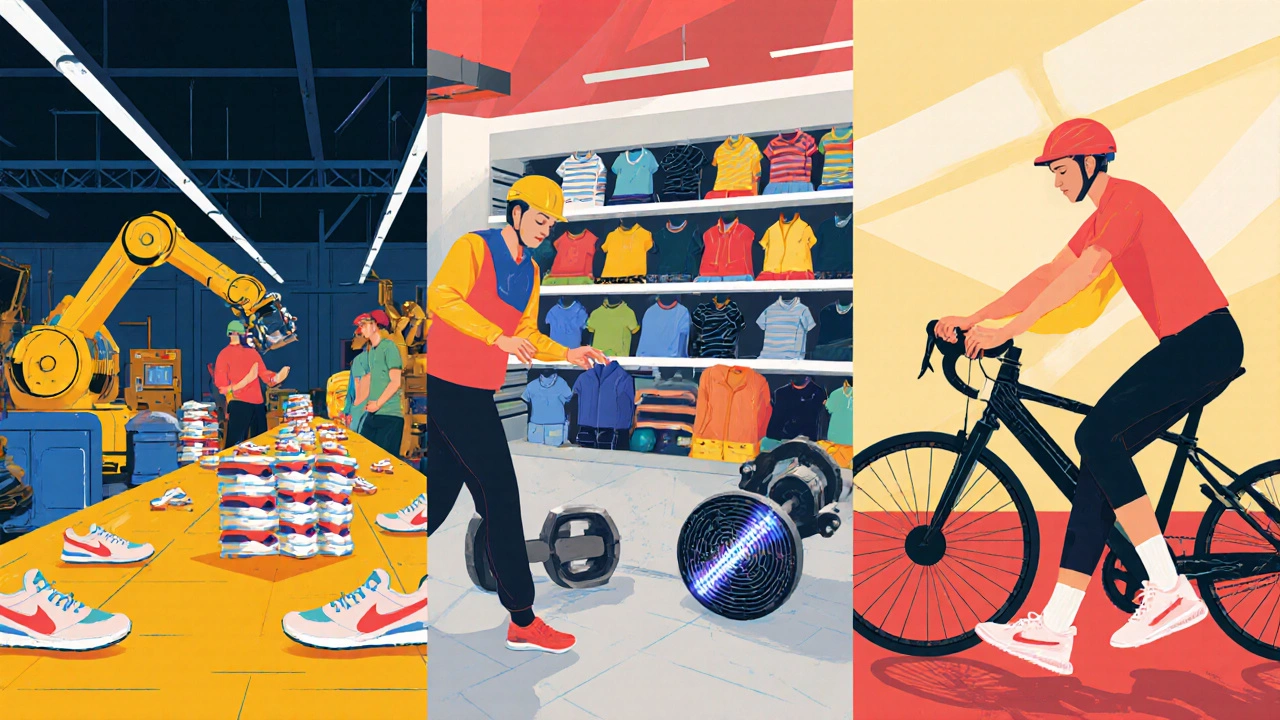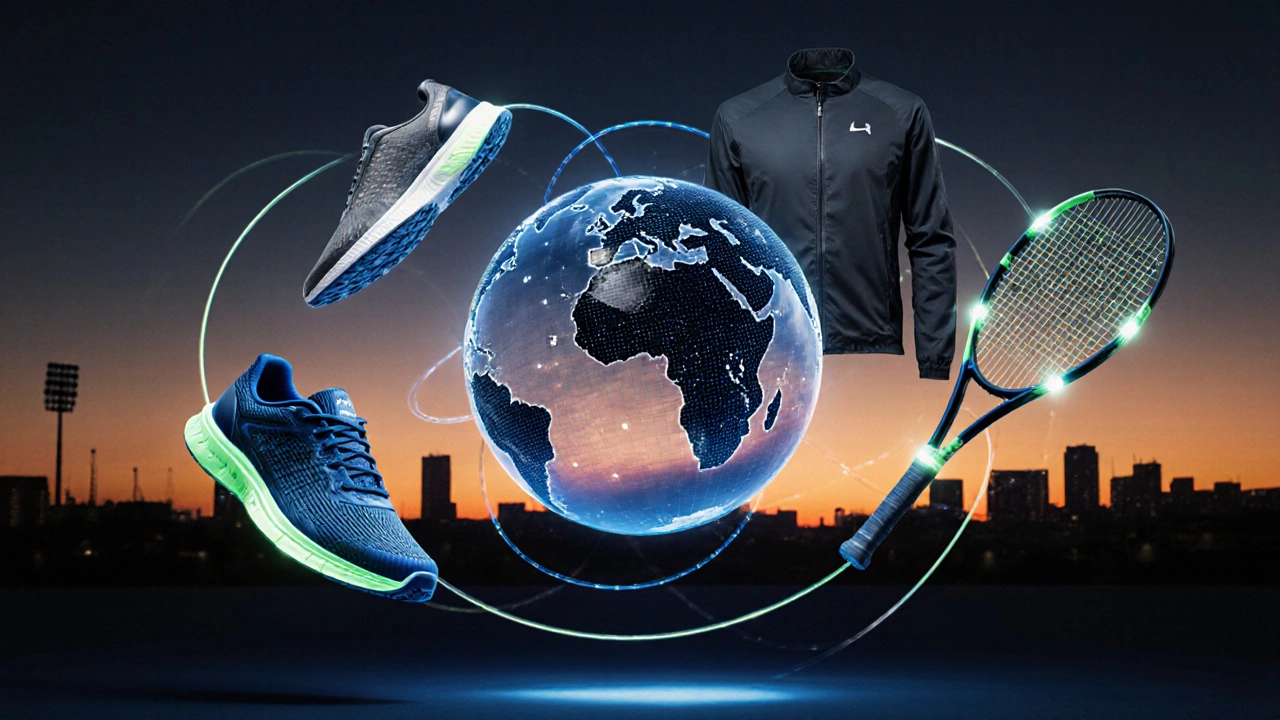Sports Equipment Market Growth Calculator
Calculate Future Market Value
Estimate the future size of the global sports equipment market based on current data and growth rates.
Projected Market Value
After 5 years at 4.5% annual growth:
US$115.2 billion
Projected value based on current market size and growth rate.
When you hear the term sports equipment industry is the worldwide market that produces, distributes, and sells gear ranging from a pair of running shoes to a high‑tech tennis racket, you might picture a few big brands and assume it’s a niche sector. In reality, the industry moves billions of dollars each year, shapes consumer lifestyles, and drives innovation across materials and digital tech. This article breaks down exactly how big the market is today, where the money comes from, which regions dominate, and what forces will shape its future.
Key Takeaways
- The global sports equipment market was valued at about US$87billion in 2024 and is projected to reach more than US$115billion by 2030.
- Footwear accounts for roughly45% of total revenue, followed by apparel (30%) and equipment (25%).
- Asia‑Pacific generated the largest share (≈38%) thanks to China, India, and Southeast Asian growth.
- Annual growth is driven by health‑focused lifestyles, e‑commerce acceleration, and tech‑enabled gear such as smart wearables.
- Key challenges include supply‑chain bottlenecks, sustainability pressures, and price competition among mid‑tier brands.
Let’s explore each piece of the puzzle so you can see exactly how massive-and how dynamic-this industry really is.
Current Global Market Size
According to the latest reports from market‑research firm Grand View Research, the worldwide sports equipment market size stood at US$87billion in 2024. That figure includes everything from a child’s first baseball glove to a professional team’s training facilities. The industry grew at a compound annual growth rate (CAGR) of 4.2% from 2019 to 2024, bouncing back from pandemic‑related disruptions.
When you add the projected CAGR of 4.5% from 2025 to 2030, the market is set to surpass US$115billion by the end of the decade. This growth translates to roughlyUS$5.2billion of new revenue each year-a scale that outpaces many traditional retail sectors.
Major Product Segments
Not all sports gear is created equal. The market splits into four primary segments, each with its own growth story.
| Segment | Revenue (US$bn) | Market Share | Key Growth Driver |
|---|---|---|---|
| Footwear | 39.1 | 45% | Comfort tech & athleisure trend |
| Apparel | 26.1 | 30% | Performance fabrics & lifestyle crossover |
| Equipment | 21.8 | 25% | Smart sensors & home‑gym boom |
| Accessories | 0.0 | - | ‑ |
Footwear leads because of the dual role it plays: functional performance and everyday fashion. In the apparel arena, moisture‑wicking polyester blends and recycled fabrics are pulling consumers toward higher‑priced, premium lines. Equipment-think bicycles, tennis rackets, and smart weights-benefits from a surge in home‑fitness setups that blend digital coaching with physical gear.

Leading Companies Shaping the Landscape
Only a handful of brands capture the lion’s share of revenue, but many niche players add depth to the ecosystem.
| Company | Headquarters | 2024 Revenue (US$bn) | Core Segments |
|---|---|---|---|
| Nike American multinational known for athletic footwear and apparel | Beaverton, USA | 46.7 | Footwear, Apparel |
| Adidas German sports‑wear giant with a strong equipment line | Herzogenaurach, Germany | 23.5 | Footwear, Apparel, Equipment |
| Decathlon French retailer that designs and sells a full range of affordable sports gear | Villeneuve d'Ascq, France | 12.3 | Equipment, Apparel, Footwear |
| Under Armour U.S. brand focused on performance apparel and connected fitness | Baltimore, USA | 5.9 | Apparel, Footwear |
| Puma German company blending sport and lifestyle apparel | Herzogenaurach, Germany | 4.8 | Footwear, Apparel |
These five firms together account for roughly 70% of total market revenue. Their dominance stems from global distribution networks, strong brand equity, and heavy investment in R&D, especially for smart‑shoe sensors and eco‑friendly materials.
Regional Breakdown: Where the Money Grows
Geography matters. Different regions show distinct buying patterns, influenced by income levels, sport popularity, and digital adoption.
| Region | Revenue (US$bn) | Share | Growth Driver |
|---|---|---|---|
| Asia‑Pacific Fast‑growing market led by China, India, and Southeast Asia | 33.1 | 38% | Rising middle class & government sport initiatives |
| North America | 23.4 | 27% | Health‑conscious consumer base |
| Europe | 19.6 | 22% | Strong club sports culture |
| Latin America | 8.5 | 9% | Young population & rising urbanization |
| Middle East & Africa | 2.3 | 3% | Investment in sports infrastructure |
Asia‑Pacific’s lead isn’t just about sheer size; it’s also the hub of manufacturing, which gives local brands a cost advantage. In North America, e‑commerce platforms such as Amazon and specialized sites like REI dominate, accelerating the shift toward online purchases.
What’s Driving the Growth?
- Health‑first mindset: Post‑pandemic, more people join gyms, run, or play team sports, creating steady demand.
- E‑commerce boom: online retail now accounts for over 35% of sports‑gear sales worldwide, especially in regions with limited brick‑and‑mortar presence.
- Smart technology: Wearable‑integrated shoes, connected tennis rackets, and AI‑driven training kits blur the line between equipment and software.
- Sustainability push: Brands that market recycled polyester or bio‑based soles see higher margins as eco‑conscious shoppers spend more.
- Rise of niche sports: Activities like pickleball, esports‑linked VR fitness, and adventure travel expand the product catalogue.

Key Challenges Facing the Industry
- Supply‑chain volatility: Raw‑material shortages (rubber, aluminum) and shipping delays can inflate costs.
- Sustainability pressures: Regulators in the EU and Australia demand greater transparency on carbon footprints, forcing costly redesigns.
- Price competition: Discount retailers and private‑label lines erode margins for premium brands.
- Counterfeit market: Online marketplaces host fake replicas, hurting brand reputation and revenue.
Future Outlook: 2025‑2030
Looking ahead, the industry’s CAGR of 4.5% suggests a steady upward trajectory. Three trends will shape the next five years.
- Digital‑first product development: Companies will embed sensors, Bluetooth, and AI analytics into everything from yoga mats to ski boots, creating new subscription revenue streams.
- Localized manufacturing: To reduce logistics costs and meet sustainability targets, manufacturers are opening micro‑factories in emerging markets, especially in Southeast Asia.
- Experience‑driven retail: Physical stores will evolve into “try‑and‑learn” hubs where shoppers can test smart gear, attend live demos, and instantly order online.
By 2030, we can expect the sports equipment market to be more connected, greener, and regionally balanced than ever before.
Quick FAQ
What was the global sports equipment market value in 2024?
The market was valued at roughly US$87billion, covering footwear, apparel, equipment, and accessories.
Which region generates the most revenue?
Asia‑Pacific leads with about US$33billion, or 38% of total sales, driven by huge populations and expanding middle classes.
What segment contributes the biggest share?
Footwear, at roughly US$39billion, accounts for 45% of the market, thanks to the athleisure trend.
How fast is the market expected to grow?
Analysts forecast a CAGR of about 4.5% from 2025 to 2030, reaching over US$115billion by the end of the decade.
What are the biggest challenges for brands?
Supply‑chain disruptions, growing sustainability regulations, and fierce price competition from discount retailers are the main hurdles.
Understanding the sheer size and the moving parts of the sports equipment industry helps anyone-from investors to fitness enthusiasts-make smarter choices. Whether you’re buying your next pair of shoes or considering a start‑up in smart fitness gear, the numbers and trends above give you a solid footing.
